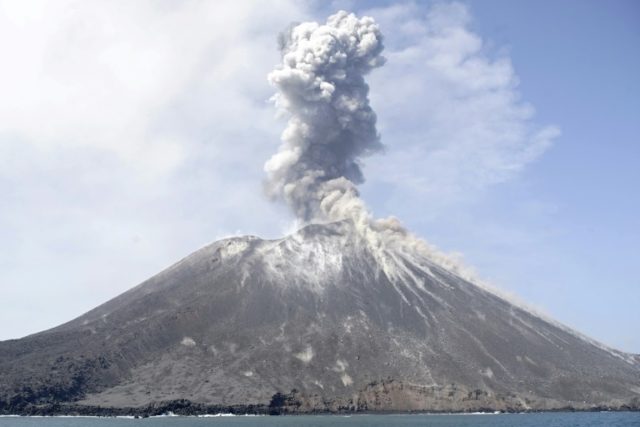Carita (Indonesia) (AFP) – At least 62 people have been killed and nearly 600 injured in a tsunami in Indonesia that may have been caused by a volcano known as the “child” of the legendary Krakatoa, officials said Sunday.
Hundreds of buildings were destroyed by the wave, which hit beaches without warning in South Sumatra and the western tip of Java about 9.30 pm local time (1430 GMT) on Saturday, national disaster agency spokesman Sutopo Purwo Nugroho said in a statement.
At least 43 people died and 584 people were injured across three regions.
Authorities say the tsunami may have been triggered by an abnormal tidal surge due to a new moon and an underwater landslide following the eruption of Anak Krakatoa, which forms a small island in the Sunda Strait between Java and Sumatra.
“The combination caused a sudden tsunami that hit the coast,” Nugroho said, but added that Indonesia’s geological agency was working to ascertain exactly how it happened.
He added that the death toll would likely increase.
Video footage posted to social media by Nugroho showed panicked residents clutching flashlights and fleeing for higher ground.
Indonesian authorities initially claimed the wave was not a tsunami, but instead a tidal surge and urged the public not to panic.
Nugroho later apologised for the mistake on Twitter, saying because there was no earthquake it had been difficult to ascertain the cause of the incident early on.
“If there is an initial error we’re sorry,” he wrote.
– ‘It went dark’ –
The wave swamped parts of the coast around the Sunda Strait between Java and Sumatra island, but was most damaging in Pandeglang district, on Java’s western tip, where 33 people died and 491 people were injured.
At Carita beach, a popular day-tripping spot on the west coast of Java, 15-year-old Muhammad Bintang described a sudden surge of water that plunged the tourist spot into darkness.
“We arrived at 9 pm for our holiday and suddenly the water came — it went dark, the electricity is off,” he told AFP.
“It’s messy outside and we still cannot access the road.”
In Lampung province, on the other side of the strait, Lutfi Al Rasyid said he fled the beach in Kalianda city in fear for his life.
“I could not start my motorbike so I left it and I ran… I just prayed and ran as far as I could,” the 23 year old told AFP
Although relatively rare, submarine volcanic eruptions can cause tsunamis due to the sudden displacement of water or slope failure, according to the International Tsunami Information Centre.
Anak Krakatoa is a small volcanic island that emerged from the ocean half a century after Krakatoa’s deadly 1883 eruption.
When Krakatoa erupted in the 19th century, a jet of ash, stones and smoke shot more than 20 kilometres (12 miles) into the sky, plunging the region into darkness, and sparking a huge tsunami that was felt around the world.
The disaster killed more than 36,000 people.
Indonesia, one of the most disaster-prone nations on earth, straddles the so-called Pacific ‘Ring of Fire’, where tectonic plates collide and a large portion of the world’s volcanic eruptions and earthquakes occur.
Most recently in the city of Palu on Sulawesi island a quake and tsunami killed thousands of people.
In 2004 a tsunami triggered by a magnitude 9.3 undersea earthquake off the coast of Sumatra in western Indonesia killed 220,000 people in countries around the Indian Ocean, including 168,000 in Indonesia.
Anak Krakatoa is one of 127 active volcanoes which run the length of the archipelago.

COMMENTS
Please let us know if you're having issues with commenting.